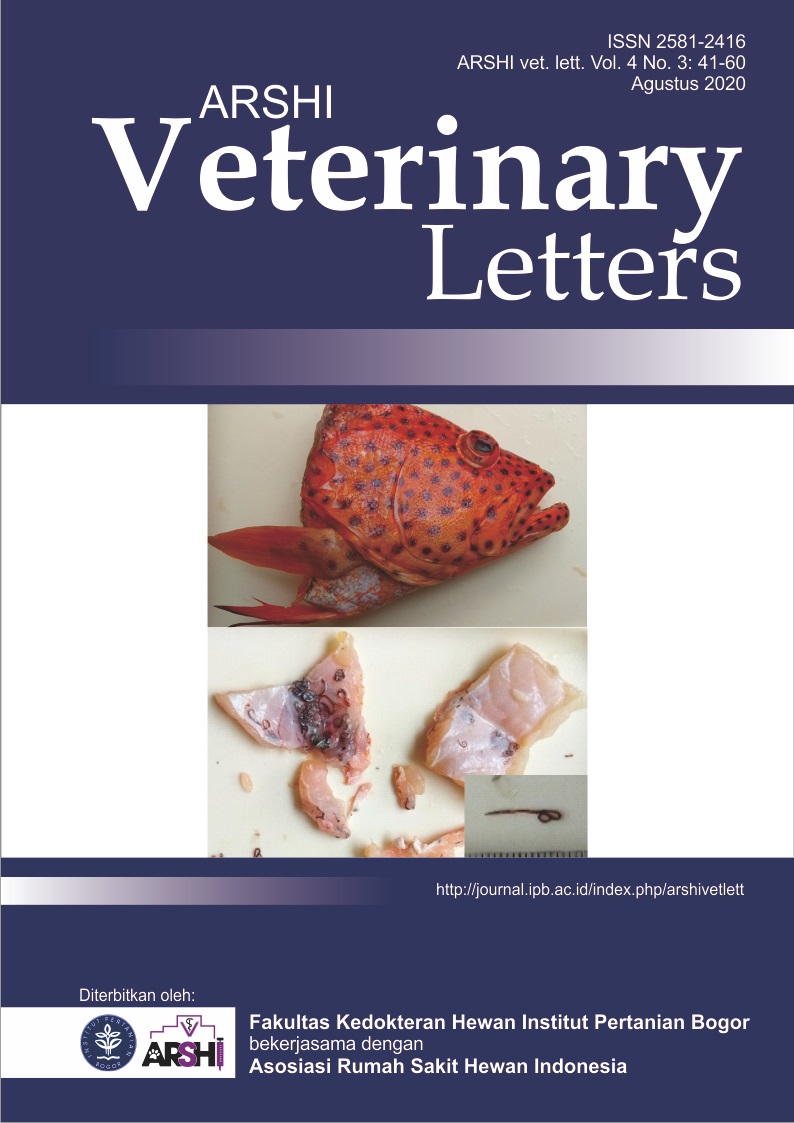Pemanfaatan Ternak dalam Pengendalian Nyamuk Vektor Penyakit
Abstrak
Mosquito are insects that cause the most health problems in society and animal, namely as nuisance insects and vector of various diseases such as malaria, dengue hemorrhagic fever, chikungunya, Japanese Encephalitis, dirofilariasis, filariasis, St. Louis Encephalitis and West Nile Virus. Control of mosquito as a vector with utilization of cattle (zooprophylaxis) needs to be done so the role of cattle is more optimize. This study aimed to know the effect of the placement of cattle around population to reduce contact between mosquitoes and human. Catching mosquitoes was done at home with two treatments, the house with cattle and house without cattle. Catching mosquitoes in human by bare leg collection method at indoor and outdoor and cattle were placed in a magoon trap. The result showed density of Cx. sitiens are known as vector of Japanese Encephalitis in human at house with cattle 12.05 mosquitoes/man/hour, in human at house without cattle 16.31 mosquitoes/man/hour, and in cattle 54.38 mosquitoes/cattle/hour. Density of Anopheles are known as vector of malaria were caught showed placement of cattle reduce contact between mosquitoes and human. Density of An. sundaicus in human at house with cattle 0.03 mosquitoes/man/hour, in human at house without cattle 0.01 mosquitoes/man/hour, and in cattle 9.63 mosquitoes/cattle/hour. This research showed placement of cattle as zooprophylaxis media around population divert mosquitoes from human to animal
Unduh
Referensi
[Depkes RI] Departemen Kesehatan Republik Indonesia. 2008b. Kunci Identifikasi Nyamuk Aedes. Jakarta (ID): Dit. Jen. PP & PL.
Dharma W, Hoedojo, Abikusno RMN, Suripriastuti, A Inggrid AT, Sutanto BA. 2004. Survei nyamuk di Desa Marga Mulya, Kec. Mauk, Tangerang. J Kedokter Trisakti. 23(2):57-62.
Ginanjar RA. 2011. Densitas dan perilaku nyamuk (Diptera: Cu-licidae) di Desa Bojong Rangkas Kabupaten Bogor [skripsi]. Bogor (ID): Institut Pertanian Bogor.
Hadi UK, Soviana S. 2010. Ektoparasit Pengenalan, Identifikasi, dan Pengendaliannya. Bogor (ID): IPB Pr.
Jan AH, Ahmad M, Khan SU. 2001. Zooprophylaxis with special reference to malaria in human population. J. Pakistan Vet.21(1):52-54.
[Kemenkes RI] Kementerian Kesehatan Republik Indonesia. 2012. Pedoman Penggunaan Insektisida (Pestisida) dalam Pen-gendalian Vektor. Jakarta (ID): Kementerian Kesehatan RI.
Mardiana, Lestari EW, Perwitasari D. 2011. Faktor-faktor yang mempengaruhi kejadian filariasis. J Ekol Indones. 10(2): 83-92.
Munif A. 2009. Nyamuk vektor malaria dan hubungannya dengan aktivitas kehidupan manusia di Indonesia. Aspirator. Vol.1(2):94-102.
New Zealand Biosecure. 2006. Culex sitiens. Auckland (NZ): Entomology Laboratory SMS (Southern Monitoring Service). 29 Nov 2006.
O’Connor CT, Supanto A.2000. Kunci Bergambar Nyamuk Anopheles Betina Di Indonesia. Depkes RI. Dit.Jen P2M & PLP. Jakarta (ID): 40 hal.
Prastowo D, Anggraini YM. 2011. Dinamika populasi nyamuk yang diduga sebagai vektor di Kecamatan Rojolele, Kabupaten Kebuman, Jawa Tengah. Jurnal Vektora. 4(2):83-97.
Prummongkol S, Panasoponkul, Apiwathnasorn, Uthai UL. 2011. Biology of Culex sitiens, a predominant mosquito in Phang Nga, Thailand after tsunami. J Insect Scienc. 12(11):1-8.
Solichah Z. 2009. Ancaman dari nyamuk Culex sp. yang tera-baikan. Balaba. 5(1):21-23.
Tirados I, Gibson G, Young S, Torr S. 2011. Are herders protect-ed by their herds? An experimental analysis of zooprophylaxis againts the malaria vector Anopheles arabiensis. Malar J. 10(1): 68. Tersedia pada: http://www.malariajournal.com/content/10/1/68.
WHO. 1993. Global Malaria Control. Bulletin WHO, 71(3-4): 281–284.
Copyright (c) 2020 CC-BY-SA

This work is licensed under a Creative Commons Attribution-ShareAlike 4.0 International License.
Authors who publish with this journal agree to the following terms:
1. Authors retain copyright and grant the journal right of first publication with the work simultaneously licensed under a Creative Commons Attribution License that allows others to share the work with an acknowledgement of the work's authorship and initial publication in this journal.
2. Authors are able to enter into separate, additional contractual arrangements for the non-exclusive distribution of the journal's published version of the work (e.g., post it to an institutional repository or publish it in a book), with an acknowledgement of its initial publication in this journal.
3. Authors are permitted and encouraged to post their work online (e.g., in institutional repositories or on their website) prior to and during the submission process, as it can lead to productive exchanges, as well as earlier and greater citation of published work (See The Effect of Open Access).












